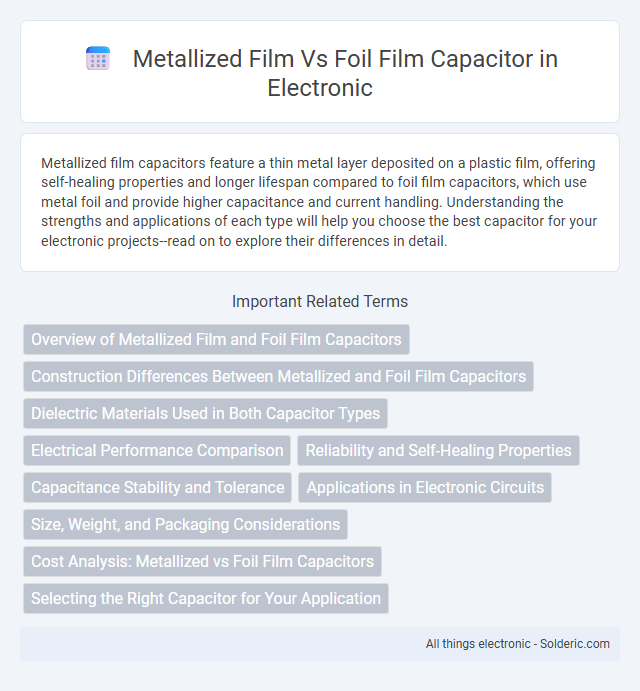Metallized film capacitors feature a thin metal layer deposited on a plastic film, offering self-healing properties and longer lifespan compared to foil film capacitors, which use metal foil and provide higher capacitance and current handling. Understanding the strengths and applications of each type will help you choose the best capacitor for your electronic projects--read on to explore their differences in detail.
Comparison Table
| Feature | Metallized Film Capacitor | Foil Film Capacitor |
|---|---|---|
| Construction | Thin metallized layer on plastic film | Metal foil and plastic film layers |
| Self-Healing | Yes, due to metallized coating | No, no self-healing capability |
| Size | Smaller and lighter | Larger for same capacitance |
| Voltage Rating | Typically up to 1 kV | Higher, up to several kV |
| Capacitance Range | Lower values, typically < 10 uF | Higher capacitance possible |
| Cost | Generally lower cost | Higher manufacturing cost |
| Applications | General use, EMI filtering, audio circuits | High voltage applications, power electronics |
| Reliability | Good, enhanced by self-healing | High, stable under stress |
Overview of Metallized Film and Foil Film Capacitors
Metallized film capacitors feature a thin metal layer deposited directly onto a plastic film, providing self-healing properties and reduced size compared to foil film capacitors, which use separate metal foil and dielectric film layers. Foil film capacitors excel in high current applications due to their thicker metal electrodes, offering superior current handling and reliability for demanding environments. Your choice depends on the specific requirements for size, durability, and electrical performance in your electronic circuits.
Construction Differences Between Metallized and Foil Film Capacitors
Metallized film capacitors feature a thin metal layer vacuum-deposited directly onto a plastic film, providing self-healing properties that enhance reliability and reduce size. Foil film capacitors consist of separate metal foil electrodes sandwiched between plastic films, resulting in lower equivalent series resistance (ESR) but larger physical dimensions. Understanding these construction differences helps you choose the optimal capacitor type for applications prioritizing size, longevity, or electrical performance.
Dielectric Materials Used in Both Capacitor Types
Metallized film capacitors use a thin plastic film such as polypropylene or polyester coated with a very thin layer of metal as the dielectric material, which provides self-healing properties and high insulation resistance. Foil film capacitors, on the other hand, employ separate metal foil electrodes sandwiched between dielectric films like polypropylene, offering higher current handling and stability under load. Understanding the dielectric materials in these capacitors helps you choose the appropriate type based on performance needs such as voltage rating, frequency response, and durability.
Electrical Performance Comparison
Metallized film capacitors offer lower equivalent series resistance (ESR) and self-healing properties, making them more reliable under transient voltage conditions compared to foil film capacitors. Foil film capacitors typically provide higher current handling and better stability at high frequencies due to their thicker conductive layers. Your choice between them should consider the specific electrical performance needs, such as ripple current capacity and frequency response, for optimal circuit functionality.
Reliability and Self-Healing Properties
Metallized film capacitors exhibit superior self-healing capabilities due to their thin metallized layer, which vaporizes micro-short circuits, enhancing long-term reliability in demanding applications. Foil film capacitors, while offering robust performance, lack this self-healing property, making them more susceptible to permanent damage under electrical stress. The self-healing feature in metallized film capacitors significantly reduces failure rates and extends operational lifespan, especially in high-voltage and high-frequency environments.
Capacitance Stability and Tolerance
Metallized film capacitors offer higher capacitance stability over a wide temperature range due to their self-healing properties, which help maintain performance after dielectric damage. Foil film capacitors typically exhibit tighter tolerance levels, making them suitable for applications requiring precise capacitance values. Your choice depends on whether stable capacitance or exact tolerance is more critical for your circuit design.
Applications in Electronic Circuits
Metallized film capacitors are widely used in electronic circuits for signal coupling, filtering, and timing applications due to their self-healing properties and stability under high voltage stress. Foil film capacitors excel in power electronics, such as in power supplies and audio amplifiers, where low equivalent series resistance (ESR) and high current handling capability are critical. Both types are essential in RF circuits and motor drives, with metallized films offering compactness and foils delivering superior performance in heavy-duty environments.
Size, Weight, and Packaging Considerations
Metallized film capacitors are generally smaller and lighter due to their thin metallized layer on a dielectric film, providing compact packaging ideal for space-sensitive applications. Foil film capacitors tend to be larger and heavier because of their thicker metal foil electrodes, which offer higher current handling but require more robust packaging. Your choice depends on the balance between size constraints, weight limitations, and the electrical performance needed for the specific application.
Cost Analysis: Metallized vs Foil Film Capacitors
Metallized film capacitors generally offer a lower cost due to their self-healing properties and thinner dielectric layers, which reduce material usage and manufacturing complexity. Foil film capacitors involve higher production costs driven by the use of thicker aluminum foils and more labor-intensive assembly processes, contributing to increased price points. Cost differences are significant in high-volume applications where metallized films provide economic advantages, whereas foil capacitors justify their expense in high-power or high-reliability scenarios.
Selecting the Right Capacitor for Your Application
Metallized film capacitors offer self-healing properties and lower ESR, making them ideal for high-frequency and pulse applications, while foil film capacitors provide superior current handling and durability under high stress or surge conditions. Your selection should consider factors like voltage rating, ripple current, capacitance stability, and physical size constraints to ensure optimal performance in your circuit. Understanding these differences helps you choose the capacitor that balances reliability and efficiency tailored to your specific application's demands.
Metallized film vs foil film capacitor Infographic

 solderic.com
solderic.com